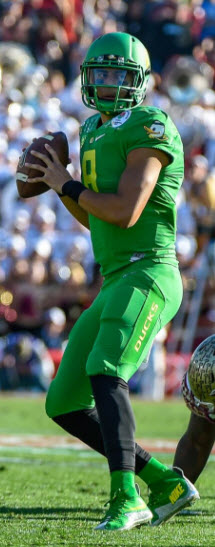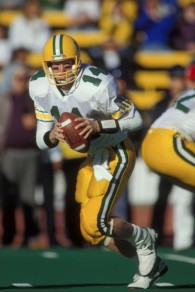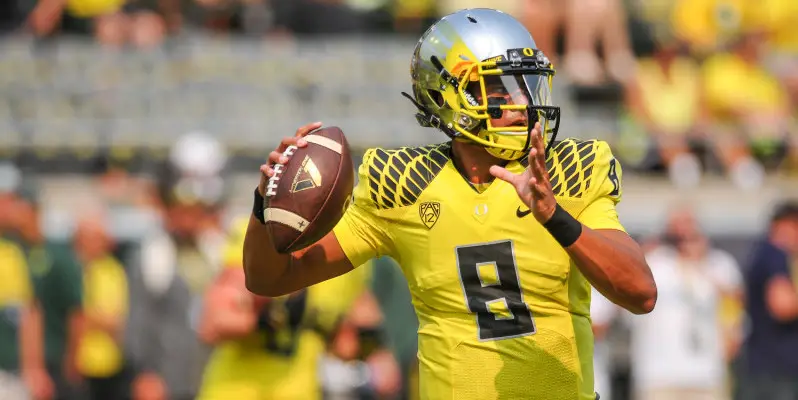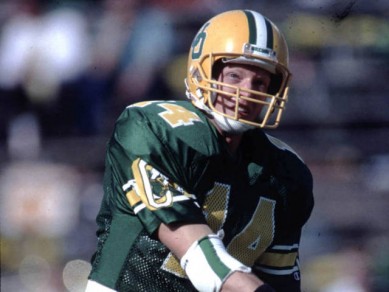“Johnny Football” may have received the most media hype among an emerging class of elite freshman quarterbacks in 2012 (deservedly so), but Marcus Mariota is arguably the most complete of the batch.
The Flyin’ Hawaiian gave the Ducks a seamless transition from Darron Thomas, who had departed early for the 2012 NFL draft. Only the third quarterback in Oregon football history to start the first game of his freshman season, Mariota established himself as an elite signal-caller, both in terms of the current college football landscape and in the context of his own program’s history.
Oregon football has seen some brilliant quarterbacks throughout its long, rich history. George Shaw, Norm Van Brocklin, and Dan Fouts are just a few of names that should be included on that list.
However, one quarterback in particular captured the hearts of Duck fans when he led the team out of mediocrity late in the 1980s. Bill Musgrave, currently the offensive coordinator of the Minnesota Vikings, is one of the most special players that Oregon football has ever seen.
After his outstanding rookie season, Mariota has achieved a sort of rock star status that encroaches on that of Musgrave. So, how do the two compare?
As it turns out, Musgrave and Mariota are actually quite similar in a number of ways, even in their appearance. Musgrave was about 6’2″ and 200 pounds, and Mariota stood in at 6’4″ and 205 pounds when he took the reigns of the offense. Both had an endearing sort of lanky, youthful look about them.
When Rich Brooks gave Musgrave the nod to start under center during his first career game in 1987, the alternative had been Pete Nelson, a far more experienced, seasoned player.
It turned out that Musgrave had all of the intangibles necessary to lead a football team to victory.
Mariota’s freshman year developed in a similar fashion. Fans had only seen his performance in the 2012 spring game, and Bryan Bennett, who is no longer with the program, had showcased some impressive talent as a freshman the year before.
In fact, in limited time as a backup in 2011, Bennett had tossed six touchdowns and 369 yards with no interceptions, adding 200 yards on the ground. Everything seemed in place for him to emerge as Oregon’s next great dual-threat option.

Marcus Mariota could do it all…
Most teams would have been thrilled to have Bennett lead their offense. But, like Mugrave, Mariota had the intangible poise and knack for winning football games, and beat out Bennett to earn the starting job.
Both quarterbacks won their debuts as starters — Musgrave in a nail-biting 10-7 win over Colorado, and Mariota in a blowout over Arkansas State.
Both quarterbacks demonstrated impressively level heads for rookie leaders. Mariota, in particular, seemed entirely comfortable during his unveiling for the Ducks, tossing three touchdowns and 200 yards with a 81% completion percentage.
Both quarterbacks ground out wins over USC teams led by Heisman-caliber signal-callers (Rodney Peete in 1987 and Matt Barkley in 2012).
Finally, both quarterbacks were tall, gangly kids that seemed to love nothing more than moving the football downfield — and they were good at it.
Musgrave’s season ended with a 44-0 shellacking of rival Oregon State, and a record-setting 1,818 total yards on the year. Mariota led the Ducks to an 11-1 regular season, a Fiesta Bowl berth, and shattered the PAC-12 freshman record with 30 passing touchdowns.
Relative to their respective expectations at the beginning of each season, the accomplishments of Musgrave and Mariota during their opening seasons are actually quite comparable. The Ducks were struggling when Musgrave took over, so a 6-5 season was a true joy for fans. Given the team’s recent elite run, Oregon football was thrilled to make another BCS bowl appearance in 2013.
The commonalities really are quite uncanny. However, heading into Mariota’s sophomore season, Duck fans are hoping that this likeness will take a bit of a break. In 1988, during his sophomore season, Musgrave spent much of the season on the sideline with injuries.
Especially with the loss of Kenjon Barner, the ground game is likely to take a bit of a hit in terms of production, so Mariota’s poise and leadership under center will be even more important this season.
Nonetheless, when healthy, Musgrave continued to produce. By the end of his tenure in Eugene, he was, and remains, the school’s all-time leading passer with 8,343 yards.
Mariota, who threw for 2,511 yards and ran for 752 more in 2012, has a chance to surpass Musgrave’s totals over a healthy career. If he were to stay in Eugene through his senior year, he would need only 1,944 yards per season to tie Musgrave’s total.

Bill Musgrave
Even if he were to leave Oregon after his junior year to go pro, Mariota would need 2,916 yards per season which, given the amount of time he spent on the sideline in 2012 due to big leads, does not seem too far out of reach.
While Mariota is likely more concerned with winning football games than how he stacks up against former Oregon greats such as Mugrave, I can’t help but draw the comparison.
Both of these quarterbacks led the Ducks to outstanding seasons as freshmen, and by the end of his career, Mariota will likely live atop the school’s leader-boards with Musgrave for decades to come.
Related Articles:
Joey Holland graduated from the University of Oregon in 2013, majoring in History. He played several sports in high school, though football remains his passion. He has yet to miss a single Oregon Ducks home football game during his time in Eugene. Joey has written previously for Bleacher Report and Football Nation.
Joey welcomes your feedback.


